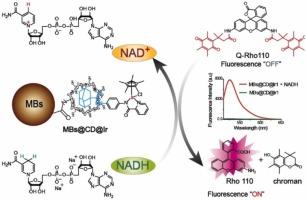Magnetic organoiridium nanocatalysts activate fluorescence biosensors
IF 8
1区 化学
Q1 CHEMISTRY, ANALYTICAL
引用次数: 0
Abstract
Here, we developed the cyclodextrin-organoiridium-functionalized magnetic nanocatalyst MBs@CD@Ir by assembling highly active adamantane-functionalized pyridinamide organoiridium complexes PicPh-Ada-Ir and cyclodextrin-modified magnetic nanoparticles MBs@CD, which could efficiently catalyze quinone hydrogenation using the cofactor NADH as a hydrogen source under physiological conditions. Furthermore, by combining the developed catalysts MBs@CD@Ir and the quinone hydrogenation-triggered Rhodamine 110-type fluorescence probe Q-Rho 110, we successfully established a sensitive cofactor NADH fluorescence sensor, which showed superior hydrogenation performance for quinone when NADH was used as a hydrogen source. The established sensor presented excellent detection performance for NADH with a limit of detection (LOD) of 4.18 nM and was successfully applied to NADH detection in Escherichia coli fermentation broth. The established sensor has successfully expanded the application of organometallic catalysts in biosensing and provides a new approach for the design of other sensors.

求助全文
约1分钟内获得全文
求助全文
来源期刊

Sensors and Actuators B: Chemical
工程技术-电化学
CiteScore
14.60
自引率
11.90%
发文量
1776
审稿时长
3.2 months
期刊介绍:
Sensors & Actuators, B: Chemical is an international journal focused on the research and development of chemical transducers. It covers chemical sensors and biosensors, chemical actuators, and analytical microsystems. The journal is interdisciplinary, aiming to publish original works showcasing substantial advancements beyond the current state of the art in these fields, with practical applicability to solving meaningful analytical problems. Review articles are accepted by invitation from an Editor of the journal.
 求助内容:
求助内容: 应助结果提醒方式:
应助结果提醒方式:


